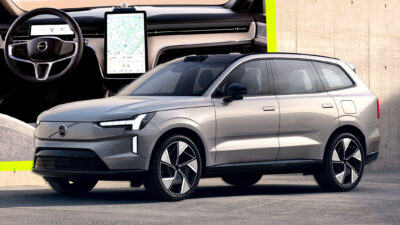Volvo and Polestar’s new electric SUVs will have enhancements to the excellent Pilot Assist system.
It’s hard to stand out at CES 2023, especially when you’re competing with color-changing cars, electric pickups that follow you like a robot puppy and an oddly-named Playstation-on-wheels. The whimsical stuff gets the headlines, but we’re also looking for the seemingly-underwhelming announcements that are going to impact our motoring lives in the short-term—such is Volvo’s news about its 2024 EX90 electric SUV using Google HD Maps.

We covered the EX90 when it made its Stockholm debut in November ’22, so here’s the quick recap: This is Volvo’s new all-electric SUV, an XC90-sized biggie that will take over as Volvo’s flagship. CES ’23 marks the EX90’s North American debut, and it did so in the Google booth, as Google integration is one of its key offerings.
Volvo’s big reveal, besides the EX90 itself, is that it will be one of the first two vehicles (the other being the Polestar 3 electric SUV) to use Google’s HD maps, which provide mapping fidelity down to the lane level. Why should you (or, for that matter, anyone) care? Because it’s going to do wonders for Pilot Assist, Volvo’s lane-centering system.

If you’re familiar with Volvos—and, unless you own one or are a die-hard Swedophile, we don’t know why you would be—you’ll already know that Pilot Assist is one of the older systems out there, and also one of the better ones. Half-a-decade ago, when most other lane-centering systems were bouncing their occupants between the dotted lines like a bowling ball trying to settle into the gutter, Volvos were guiding themselves straight and true, so long as you kept a hand on the wheel. Several systems have now caught up, and some, such as GM’s SuperCruise, have surpassed it, primarily because they allow you to take your hands off the wheel, particularly on long, boring stretches of road where we’d be just as happy as a passenger.
The addition of HD maps—and the EX90’s giant lidar sensor, which lives above the windshield like the roof sign on a London taxi—indicate Volvo’s intention for Pilot Assist to go hands-off, at least part of the time. If the mapping data is good, and given our experience with Google, we think it ought to be, Pilot Assist could once again move to the head of the class. Volvo showed animations with automated lane changes, and that makes us happy: Super Cruise’s change-lanes-then-pass-then-return functionality is pretty hard to beat, at least for those of us who believe the world would be a better place if slower traffic kept right.
Aside from HD maps, the full Google integration in the EX90 is also worthy of note. For the EX90—and, we hope, for future Volvos, in which massive design changes seem to come only once every one-fifth of a century whether they are needed or not—Volvo’s piddly portrait-sized screen is replaced by a giant tablet, as seen in Ford’s Mustang Mach-E among others. In keeping with Volvo’s minimalist bent, the system is intended to be voice primarily driven: Utter the magic words “Hey Google” and, just as on your phone, you can command the EX90 to do all sorts of useful things: Navigate home, find you some dinner, even turn on (or off) Google-connected smart devices in your home.

During the short demo we were given, the system locked up twice, flustering the poor Google rep (we were her first demo of the day) and amusing us to no end. Granted, this was a prototype, non-finished software, excuse, excuse, explanation, explanation. Given our experience with Volvo’s infotainment systems, we were not nearly as surprised as the Google rep. Hopefully Volvo’s contract with Google includes a thorough debugging, because we’re looking forward to seeing how this seemingly-minor announcement enhances the driving experience of the EX90 and other Volvo vehicles.








